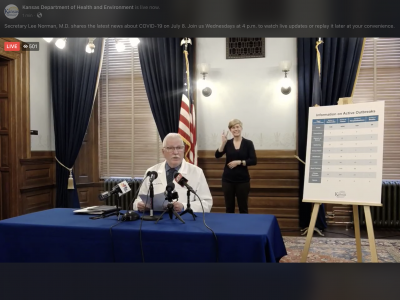Science proves that masks, other public health measures work to slow spread of COVID-19, Kansas health secretary says

Dr. Lee Norman, secretary of the Kansas Department of Health and Environment, speaks at a media briefing on Wednesday, July 8, 2020 at the Kansas Statehouse in Topeka.
Kansas’ top health official said Wednesday that the state continues to see a significant increase in COVID-19 cases — mostly due to an effort to “return to normal” that has seen folks across the state gather in larger numbers without proper precautions.
Now more than ever, it is crucial that Kansans wear masks and practice social distancing and sound personal hygiene if the state is to slow the rapidly spreading respiratory virus, said Dr. Lee Norman, secretary of the Kansas Department of Health and Environment.
In a media briefing Wednesday, Norman cited a just-released study published in Nature, a British scientific journal, that studied the spread of COVID-19 in six countries. When those countries put preventive measures such as social distancing and mask-wearing in place, they prevented some 62 million COVID-19 infections. What’s more, Norman said, recent research has shown that mask mandates can reduce COVID-19 infection rates by 1% to 2% per day and decrease an area’s mortality rate ninefold.
“This question has been asked and answered,” he said. “Masks work.”
More and more, Norman said, data is reflecting that large gatherings are where this virus spreads. Kansas is still not at a point, though, where it would necessarily need to backtrack into more restrictive gathering limits — if people take the needed precautions such as wearing a mask and staying 6 feet apart.
“Gatherings are where the virus is mostly transmitted,” Norman said. “It would make sound public health advice to (more strictly limit gatherings). But I don’t think it would be necessary if people would do all of those other things.”
KDHE on Wednesday confirmed an additional 717 cases of COVID-19 since data was last released on Monday, bringing the state’s cumulative case total to 17,618. The state also confirmed another two deaths attributed to the virus, which has now killed 282 Kansans.
The department also began releasing new data detailing the number of confirmed COVID-19 cases in which the patients did or didn’t exhibit symptoms. Of the 17,618 cases, 10,588 patients showed symptoms of the virus, 5,426 patients did not, and the symptom status of the remaining cases was unknown.
The 717 new cases were out of a total of 6,263 tests — a positive rate of 11.4%. Experts have long said, and Norman reiterated Wednesday, that it is concerning when a state has a positive testing rate above 10%, especially with increased testing capability.
“Our percent positive (rate is) going up all the time. In April, it was common to see runs of 2%, 3%, 4% positive test rates,” he said. “It’s an ominous trend to be doing more testing with higher incidence of positive tests … Anything above 10% is problematic.”
Despite spiking cases, Norman said Kansas continues to be in good shape with hospital capacity and testing capability.







